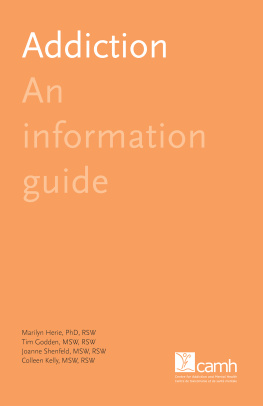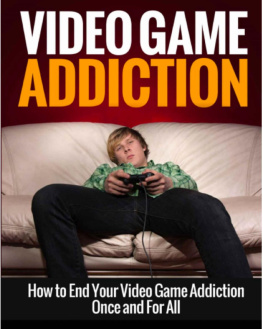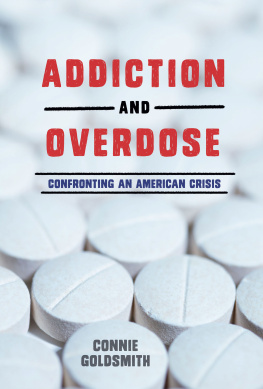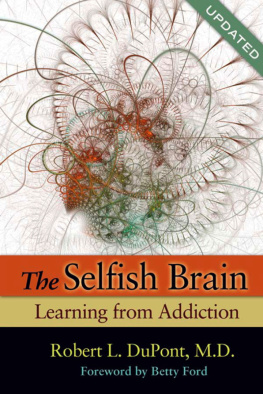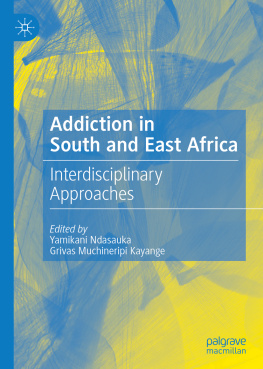ADDICTION AND ART
ADDICTION AND ART
Addiction and Art
EDITED BY
Patricia B. Santora
The Johns Hopkins University School of Medicine
Baltimore, Maryland
Margaret L. Dowell
Mount St. Marys University
Emmitsburg, Maryland, and
Carroll Community College
Westminster, Maryland
Jack E. Henningfield
The Johns Hopkins University School of Medicine
Baltimore, Maryland, and
Pinney Associates
Bethesda, Maryland

2010 The Johns Hopkins University Press
All rights reserved. Published 2010
Printed in Canada on acid-free paper
9 8 7 6 5 4 3 2 1
The Johns Hopkins University Press
2715 North Charles Street
Baltimore, Maryland 21218-4363
www.press.jhu.edu
Library of Congress Cataloging-in-Publication Data
Addiction and art / edited by Patricia B. Santora, Margaret L. Dowell, Jack E.
Henningfield.
p. ; cm.
Includes bibliographical references.
ISBN-13: 978-0-8018-9481-7 (hardcover : alk. paper)
ISBN-10: 0-8018-9481-6 (hardcover : alk. paper)
1. Drug addiction. 2. Art. I. Santora, Patricia B., 1949 II. Dowell, Margaret L.
III. Henningfield, Jack E.
[DNLM: 1. Substance-Related Disorderspsychology. 2. Art Therapy. 3. Medicine in
Art. 4. Substance-Related Disordersrehabilitation. WM 270 A22309 2010]
HV5801.A275 2010
362.290222dc22 2009030922
A catalog record for this book is available from the British Library.
Special discounts are available for bulk purchases of this book. For more information, please contact Special Sales at 410-516-6936 or specialsales@press.jhu.edu.
The Johns Hopkins University Press uses environmentally friendly book materials, including recycled text paper that is composed of at least 30 percent post-consumer waste, whenever possible. All of our book papers are acid-free, and our jackets and covers are printed on paper with recycled content.
It is art that makes life, makes interest, makes importance...
and I know of no substitute whatever for the force and beauty of its
process.
Henry James to H. G. Wells
Letter of July 10, 1915
21 Carlyle Mansions, Cheyne Walk, London
ACKNOWLEDGMENTS
We gratefully acknowledge the grant support of the Robert Wood Johnson Foundation, whose sponsorship through the Innovators Combating Substance Abuse Awards Program made this unique book possible. Early encouragement of the concept of art as a viable and important approach for communication as well as a complement to science in understanding the human side of addiction was provided by former Surgeon General C. Everett Koop, American Visionary Art Museums founder and director, Rebecca Alban Hoffberger, former first lady of Maryland Kendel Ehrlich, and Innovator Award recipient Ray Materson.
We are indebted to the members of the Innovators Addiction Art Advisory Board (see Appendix A), who committed two days to a think tank meeting to review and select the art and to discuss the pivotal role that addiction art plays in education about, treatment of, and prevention of substance use disorders.
We are grateful to Keith Weller of Columbia, Maryland, for his superb photography of the original art contained in this book. Mr. Weller photographed the majority of the art while it was on display at the annual meeting of the College on Problems of Drug Dependence, San Juan, Puerto Rico, June 2008.
We appreciate the excellent editorial assistance of the editors and staff of the Johns Hopkins University Press in preparing this book.
Most of all, we are grateful to the contributing artists whose art highlights the need to seek more effective ways to treat addictions and to help individuals achieve recovery.
INTRODUCTION
This book marks the intersection of science and the visual arts. It captures the real-world experience of addiction and recovery as revealed through the visual arts and the written word. Organizing a collection of art devoted to substance abuse and addiction could be seen as falling outside the sphere of addiction science. What does art have to do with addiction, anyway? Science helps to explain the phenomena of addiction, but artistic expression helps us to understand it in a way that is complementary and no less insightful. Science gives us the tools, but art gives us the inspiration and the drive to make a difference in reducing addiction and helping people achieve recovery. What is more importantthe tools or the drive? They are inseparable.
By combining science with art, two seemingly disparate disciplines, we seek not to supplant the scientific view of addiction and its treatment but to complement it. Our primary goal for this collection of art is to reveal the human experience of addiction so that readers may reach a new understanding of addiction as a chronic medical illness requiring treatment. With this view of addiction directing our efforts, we adopted the fundamental strategy that former Surgeon General C. Everett Koop proposed: to fight addiction instead of fighting those who have it.
Addiction science tells us that substance abuse and addiction are among the most prevalent, deadly, and costly health problems in the United States. They account for approximately one in five deaths annually500,000 personsand more than one-half trillion U.S. dollars. With the medical, social, and psychological toll from undiagnosed and untreated substance abuse reaching epidemic status, what can be done to refocus our countrys strategies to prevent and reduce the harm caused by substance abuse?
Addiction art conveys the human experience of addiction that lies hidden behind the statistics of addiction science. It shows us how individuals, families, and communities live with addiction. Addiction art reveals the many-faceted struggles of those entrapped in a life ruled by addiction. Whereas science analyzes and explains addiction using data displayed in pie charts and bar graphs, art reveals the tangled complexity of addiction through works made of paint and other materials to enhance our understanding of this treatable chronic illness.
Our intent is to help people from all walks of life recognize, first and foremost, that addiction is never only about alcoholics or addicts; it is also about the families and communities whose lives intertwine with those of addicted persons in myriad ways. We hope these art works, individually and collectively, will make it easier for all of us to welcome people with addictions back into the human community.
This volume provides opportunities to raise consciousness and change behavior. By engaging peoples feelings and perceptions, art can help change awareness. We hope that these images will highlight the need to continue seeking more effective ways to treat addictions and thereby help individuals achieve recovery and become integrated into the everyday lives of our communities in positive ways. We also hope that the collection highlights the importance of prevention and re-energizes efforts to reach out to individuals at risk, especially young people.
This collection represents an extraordinary collaboration among individuals from very different communities: the artists whose work is represented here and a unique advisory group of addiction scientists and art professionals. The contributing artists brought their individual talents and experience with the world of addiction to the works they submitted. The members of our advisory group brought not only their professional expertise to the endeavor but also their personal experience of art. Many also brought a perspective influenced by close personal contact with a family member, friend, or colleague suffering from substance abuse or addiction.
Next page

